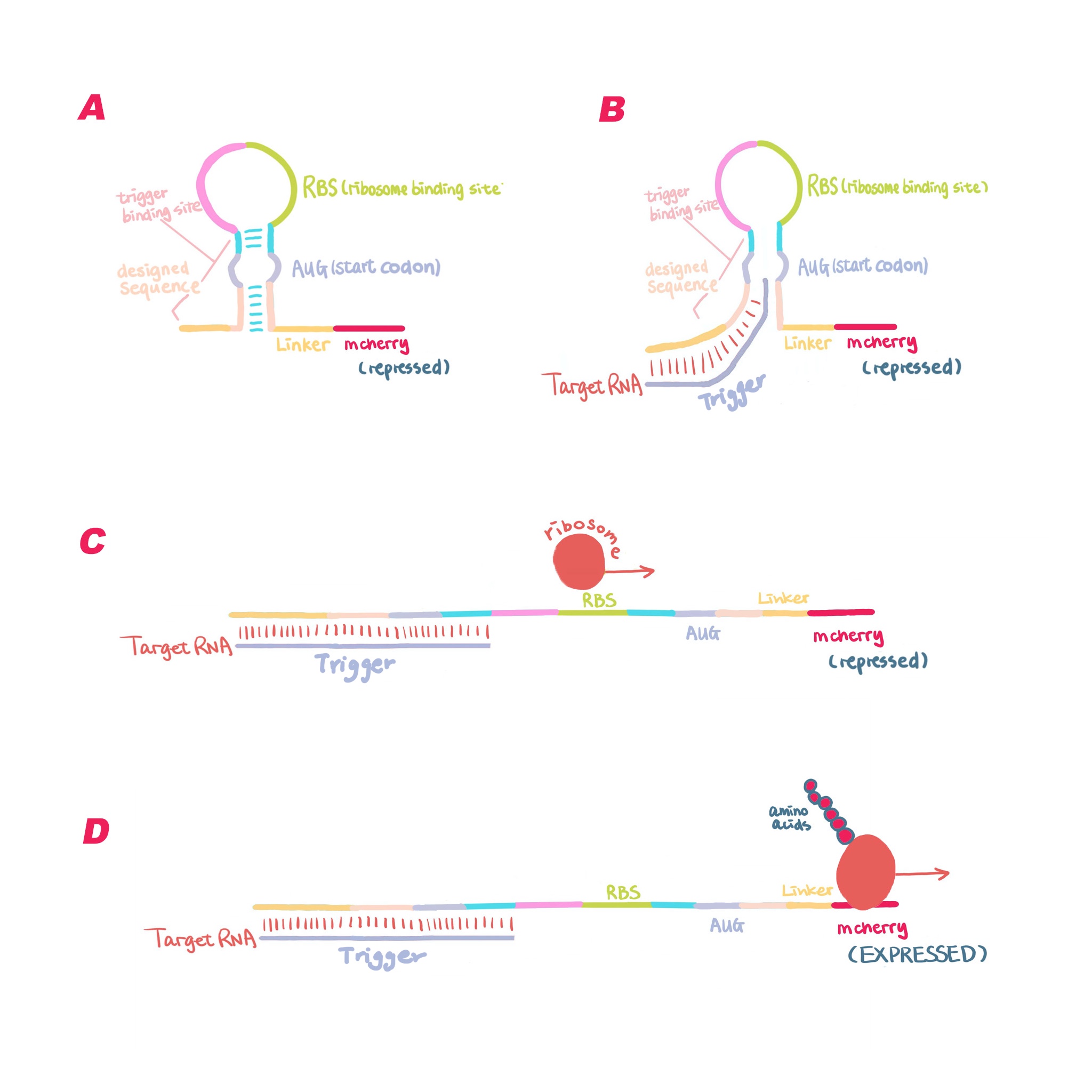Part:BBa_K3577001
Toehold Switch
Toehold switch repress translation through it’s hairpin structure, which hind the RBS and start codon (AUG). The trigger sequence, a RNA sequence that complete reverse complementary with trigger strand of Toehold Switch, is a key to start translation. When the two linear RNA are complementary, the stem-loop will open, the ribosome will bind to the RBS, recognize the start codon and start translation.
Sequence and Features
- 10COMPATIBLE WITH RFC[10]
- 12COMPATIBLE WITH RFC[12]
- 21COMPATIBLE WITH RFC[21]
- 23COMPATIBLE WITH RFC[23]
- 25COMPATIBLE WITH RFC[25]
- 1000COMPATIBLE WITH RFC[1000]
Usage and Biology
In our project, the trigger sequence is linked to DNA fragment of biomarker by DNA amplification. After in vitro transcription, the biomarker RNA will also be connected with trigger. The product with trigger can open the stem-loop structure and form a red fluorescent protein, which is the visible observation result.
Our haripin structure of toehold switch is as follows:
From the first red part to the first green part is the reverse complementary sequence with trigger. The dark blue 9 bases are the stem bottom sequence, the light green 6 bases are the stem top sequence that near the loop, the orange part is the loop where the yellow background is the RBS ribosome binding site (RBS ) sequence, We focus on modifying the 7 bases (CAGAAAC, orange color) before RBS, which make RBS more easily exposed and improve translation efficiency. The last black sequence is the linker, which helps to indicate the correct folding of the protein.
Results
After completing the design of toehold switch, we contructed T7 promoter and toehold switch as well as mCherry into pSB1C3 backbone (BBa_K3577000), which could be used as materials for in vitro transcription / translation.
The in vitro transcription/translation procedure is based on S30 T7 High-Yield Protein Expression System from Promega, the PCR product of PCA3 (we called it “PCA3 product” later) was selected for validation during this step. Adding the amplified PCA3 products as well as the toehold plasmids into the E. coli cell-free protein synthesis system and starting reaction, the final visual result can be found.
The results were as anticipated: the control group 1 without toehold plasmids showed no sign of red fluorescence; the control group 2 without PCA3 products showed faint fluorescence; and the samples containing PCA3 products and toehold plasmids showed brilliant fluorescence (Figure 3).
The toehold plasmid was also used in the validation of synthetic urine test. After choosing the primer and verifying the efficiency of overhang-added primers and in vitro transcription/translation process, we use synthetic urine (CAS Number: R23032-500ml, Shanghai yuanye Bio-Technology Co., Ltd) to simulate the usage of our product. PCA3 mRNA was added into synthetic urine in advance. A standard curve for the detection of PCA3 in synthetic urine is ploted to determine the effective interval of copies of PCA3 in urine for the detection. By using the 4-parametric regression model to fit a curve of fluorescence and PCA3 copies, we obtained the following graph. The curve possesses a “S” shape. Between a copy number of 0 to 50, a relatively flat curve is observed, where the value of fluorescence increases slowly along with the increase of PCA3 copies. Then, after entering the phrase between 50 to 1000 copies, the fluorescence values increases quite sharply until they gradually show the tendency of leveling at 1000 to 2000 copies. The fluorescence value increased linearly in the range of 200-800 copies, indicating that the amount of PCA3 mRNA in this range is the effective identification range of the product (Figure 4&5) .
We selected the value of 300 copies in the linear rising region of the standard curve as the amount of PCA3 mRNA for reliability test. Then 300 copies of PCA3 was randomly added to 96 urine samples, the final reaction solutions were added to 96 well plate for fluorescence determination ( Figure 6).
Plotting data on the graph and linking them can obtain us an empirical ROC curve to analyze the accuracy of clinical trials. ROC curves possess an x-axis of true positive rate, or sensitivity, and the y axis represents false positive rate, or specificity. Sensitivity and specificity have an inverse correlation, and a trade-off must take place for each of these points on the graph. The values of points indicate the percentage of true and false positivity, and therefore evaluates the reliability of our method. The AUC (area under curve) value can be used to describe to effectiveness of our diagnostic method. Using R program, the AUC value is calculated to be 82.4%, which means that our diagnosis method is quite effective (Figure 7).
Followed experience is supplemented by 2021 iGEM YiYe-China
This is new data collected from laboratory experiments by YiYe-China. Our project is to detect colorectal cancer through the toehold method. So we first verify the feasibility by testing this part.
Methods
Plasmid pBS1C3 with toehold-mcherry and pCOLAD-trigger were transformed into E. coliBL21(DE3) strain.Single colony was selected to inoculate LB broth containing kanamycin and cultured overnight.
Results
As shown in the figure 1, the expression of fluorescent protein can be observe in E.coli.And the fluorescence value of only toehold is much lower than that of toehold with trigger, which shows that only toehold can not cause fluorescence,but with trigger lead to a very different fluorescence value(Fig.2). Prove that the toehold system can work to open the hairpin cause a fluorescence.
Conclusion
According to our experimental results:
1. Compare with the control group, there is obvious red light, and the fluorescence value is much higher than others, which is consistent with the initial results of this part.
2. Only very low fluorescence values occur in toehold alone,due to a small amount of leakage,a few fluorescent signals is generated however, it has been shown that the fluorescence value of toehold and trigger is very different from the toehold alone, and the value is much higher than the toehold alone, which proves that its toehold system is working properly.
| None |








